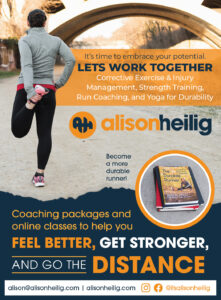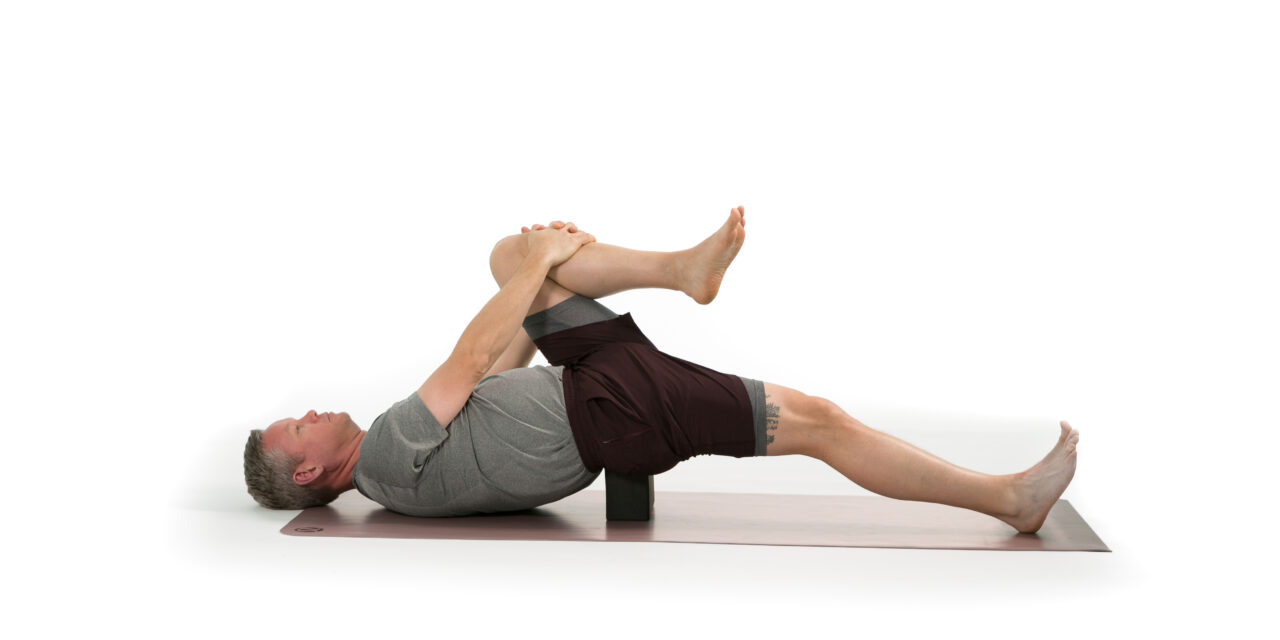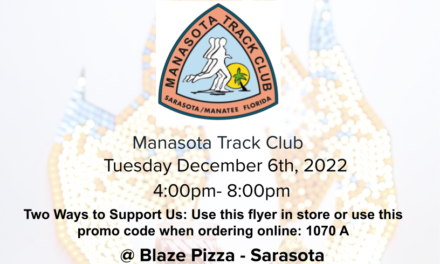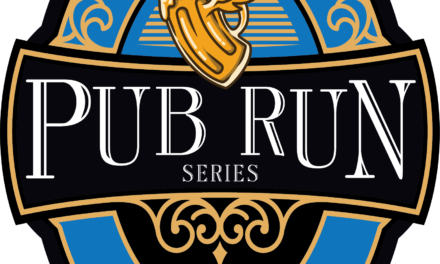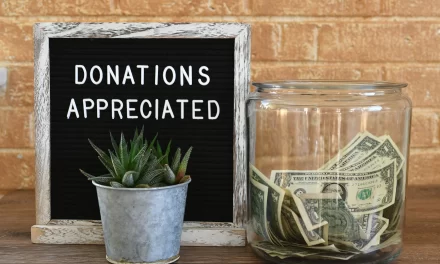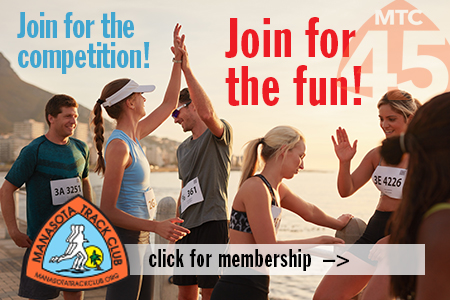Alison Heilig is an ultramarathoner, strength and running coach, yoga teacher, and author of The Durable Runner. She specializes in working with runners who are experiencing persistent pain and/or reoccurring injury to get them back to running and help them continue to run well for years. She is more than happy to share her tips with the MTC. Learn more about Alison, her coaching plans, and her online classes at www.alisonheilig.com.
Even though we know that sitting doesn’t do us any favors as runners, for many of us there really isn’t a way around it in modern life. So much of what we do every day actually requires us to be parked in one spot for long periods of time.
Like most children, I ran around outside a lot as a child. But then after spending years of sitting in school, then university, then at my law firm desk, one day in my mid-20s I decided to go for a run … and then another … and then another. And it didn’t take long for the aches and pains to start. Running was nothing like I remembered. How and when had running become so hard?
After being diagnosed with a long string of running injuries including a stress fracture in my hip at age 30, I began to investigate all the ways that my habits might have contributed to the pain and injuries I experienced, especially the hip impingement – or as I called it “my pinchy hip” – that likely lead to the fracture. It became increasingly obvious to me that humans are simply not designed to spend our lives sitting for long periods then get up and move fluidly and well. Bummer.
However, my investigation also gave me hope because I discovered that there are some really simple ways to counter all the changes that happen in our tissues during long periods of sitting that will help us keep running well in spite of our sitting habits. I implemented lots of small changes in my own life and went on to run a bunch of ultramarathons without injury.
Now in my 40s, I still sit quite a bit to run my online strength, running, and mobility coaching business and I still run often without injury or pain. Through the years, I’ve been able to really dial in on which specific mobility and strength movements give me and my body the maximum impact for the time invested because, like most people, I’ve got lots already on my plate but I also really want to continue to enjoy running.
I recommend that everyone do the same for their own body as well and I wrote a book, called The Durable Runner, that’s full of suggestions and ideas for how to feel better, run better, and zero in on what will have the most benefit for your individual needs. There’s a chapter that covers each specific area of the body in depth and offers mobility, strength, and self-myofascial release (SMR) work. Like an a la carte menu, you can pick the things you like and create a new habit that will support you and your running for years to come.
Here are a few of my favorites from The Durable Runner to get you started.
Calf SMR
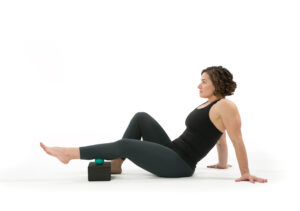
Sit on the floor and place a myofascial ball (a tennis ball or lacrosse ball will work fine too) on top of a yoga block or stack of books right in front of you. Place your hands on the floor behind you and lean back. Rest your left calf on top of the ball. Roll around a little there until you find a spot that feels tender, but not unbearable, and pause there for a few breaths. For more pressure, you can cross your right leg over the top of your left leg. You might also try circling your left ankle or pointing and flexing your left foot. Spend about a minute or two on your left leg, working up toward your left knee and down in the direction of your left heel. Switch sides and repeat.
Gluteus Medius SMR
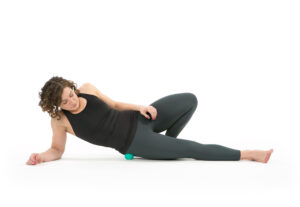
Lie on your back with your knees bent, feet flat on the floor. Place a myofascial ball under the upper portion of the back of your outer right hip – basically, right where your right back pocket would be in a pair of fitted jeans. Extend your right leg and roll more of your weight onto your right hip as you support yourself on your right forearm. When you find a tender spot, be still, breathe, and try to soften into it as you relax your whole right leg as much as possible. Stay for about 30 seconds and then move around a little bit in that area and find another tender spot where you can stay for a few breaths. Then, repeat on your left leg.
Block Hip Flexor Stretch
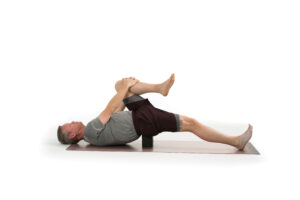
Lie on the floor with your knees bent, feet flat on the floor. Place a yoga block or foam roller under the back of your hips so that no part of your lower back is on the block or foam roller. Hug your left knee into your chest and extend your right leg with your right heel resting on the floor. With a small bend in your right knee, as you inhale, press your right heel down into the floor and stretch it away from your head. As you exhale, draw your left knee in a little closer. Your legs should feel active and engaged but try to relax and soften your hips and lower back. Stay for 5-10 breaths and then switch sides.
T-Spine Mobilization
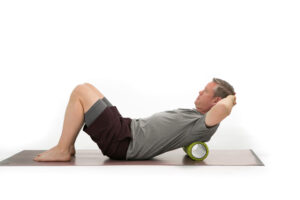
Position a foam roller across your upper back, about level with the middle of your shoulder blades. Interlace your hands behind your head and rest your head back into them. Keep your hips on the floor and instead of just leaning all the way back, tuck your tailbone under you slightly and don’t let your lower back lift away from the floor. Keep your front ribs gently drawing back as you lean your upper back and rib cage back over the foam roller. Use your core muscles to minimize the tendency for your lower back to arch. You won’t go as far without arching your lower back but that’s okay because we’re actually trying to get the movement to come from the ribcage leaning back over the roller. Stay for a few breaths then move the roller up or down an inch or two and repeat.
Stability Ball Dead Bug
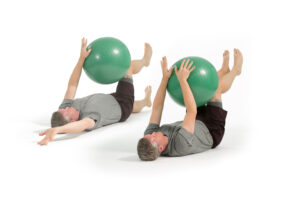
Lie on your back with your knees bent and positioned over your hips, shins parallel to the ground. Using your forearms, brace a stability ball against your thighs. Gently press the skin of your lower back into the floor. As you inhale, straighten your left leg out and extend your right arm over your head. As you move, keep the front of your core engaged and your lower back pressing into the floor. Move slowly enough that you can detect if your lower back arches away from the floor or your lower ribs flare. With your exhale, slowly return your left leg and right arm to the starting position and repeat with your right leg and left arm. Perform a few sets of 10 reps per leg, alternating sides. NOTE: You can also do this without the ball but I love how pressing into the ball gives my hip flexors a little extra boost of activation.
Single-Leg Glute Bridges
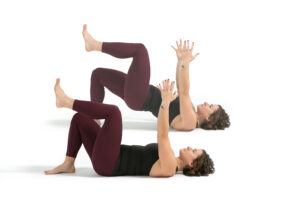
Lie on your back with your knees bent, feet flat on the floor. Extend your arms upward so that your palms face each other, hands directly over your shoulders. Press your upper back and the back of your shoulders into the floor for stability. Lift your left foot up so that your left knee is directly over your left hip with your left shin parallel to the floor. Tuck your tailbone under slightly and press into your right foot to lift your hips up. Keep your hips level throughout the movement and don’t let your lower back arch as you lift and lower – tailbone tucked at the top, core engaged throughout. Lower your hips and repeat. Perform a few sets of 8-10 reps per side.
Foot Banded Lateral Walks
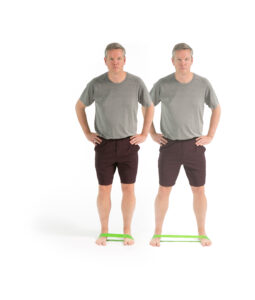
Place a mini band loop around the balls of both of your feet. Bend your knees slightly to come into a quarter-squat position. Place your hands on your hips and pick your left foot up and step it to the left. Then step your right foot toward your left foot. Try not to shift your hips with each step and don’t let your toes or knees turn inward or outward – keep them both pointed straight ahead. Then repeat by stepping again to the left with your left foot, followed by your right foot. Perform a few sets of 10 steps per side.
Bio:
Alison Heilig is an accomplished ultramarathoner, triathlete, and a competitor in both CrossFit and Olympic Weightlifting. She is a Level 2 RRCA-Certified Running Coach, a certified Personal Trainer (CPT) and Corrective Exercise Specialist (CES) through the National Academy of Sports Medicine, and a Yoga Medicine™ Therapeutic Yoga Specialist. Using corrective exercises and therapeutic practices, Alison helps individuals overcome pain and injury and increase physical and mental resilience so they can get back to doing the physical activities that give their life purpose and make them feel whole.
Her book, The Durable Runner, combines corrective exercise, self-myofascial release, and yoga to help runners develop a solid training strategy to remain physically and mentally durable. She is currently working on her second book, tentatively titled Durability. She lives in the Maryland suburbs of Washington, DC with her husband Chris. Find her on Instagram @itsalisonheilig.
